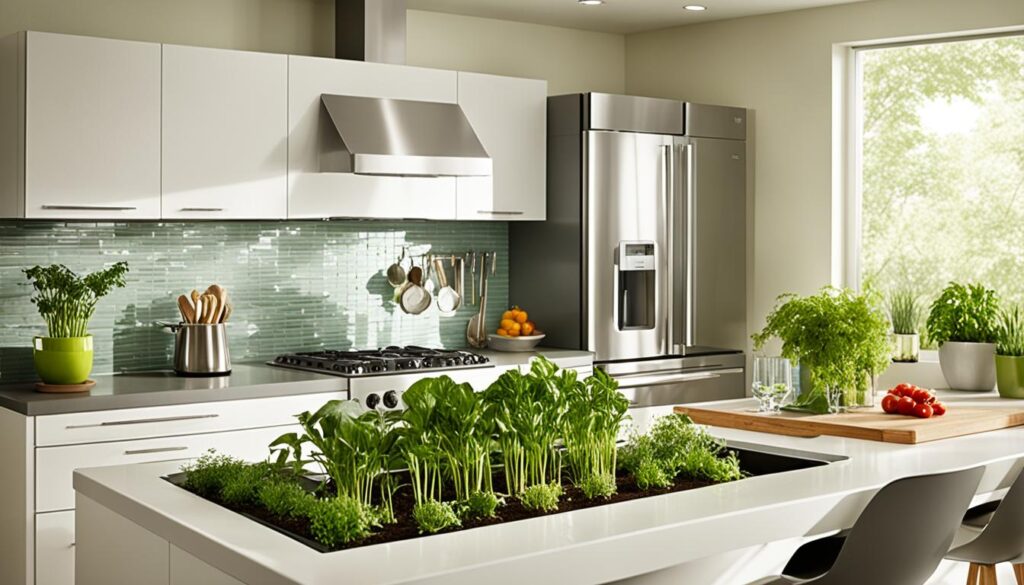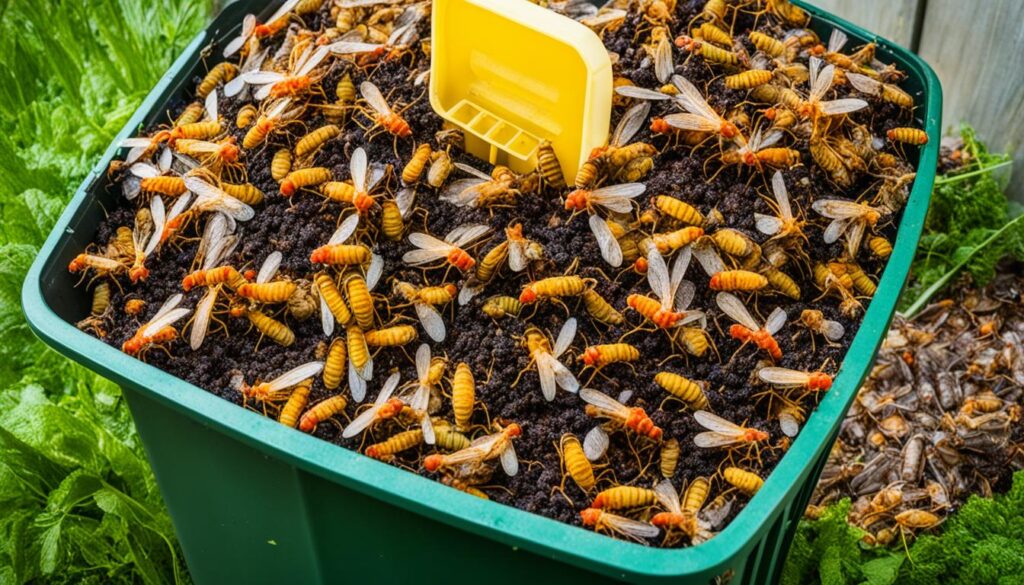Sustainable cooking practices are essential for creating an eco-friendly kitchen. By implementing energy-efficient food preparation and cleaning habits, using sustainable materials for cookware and utensils, and avoiding toxic chemicals, you can make a positive impact on both your well-being and the environment. Let’s explore some simple yet effective tips for preparing earth-friendly meals that will turn your kitchen into a greener and healthier space.
Key Takeaways:
- Implement energy-efficient cooking techniques to reduce your carbon footprint.
- Choose sustainable cookware and utensils made from materials like stainless steel or cast iron.
- Consider the pros and cons of gas stoves versus electric stoves for energy efficiency.
- Practice green cooking methods such as preheating selectively and utilizing small appliances.
- Minimize food waste by practicing sustainable food storage and buying locally.
Choosing Sustainable Cookware and Utensils
When it comes to creating a sustainable kitchen, making conscious choices about the cookware and utensils you use is essential. By opting for sustainable options, such as stainless steel cookware and cast iron cookware, you can contribute to a greener and healthier cooking environment.
Unlike non-stick surfaces like Teflon, which have limited lifespans and potential health hazards, stainless steel and cast iron cookware are durable, long-lasting, and can be passed down for generations. Their sturdy construction ensures even heat distribution and excellent heat retention, making them perfect for a variety of cooking methods.
Investing in high-quality utensils and knives that can be sharpened by hand is also a sustainable choice. By avoiding disposable and low-quality utensils, you can reduce waste and have tools that will last for years.
Another simple yet effective way to promote sustainability in your kitchen is by using cloth towels instead of paper towels. These reusable towels not only minimize waste but also help maintain a cleaner and more eco-friendly cooking space.
Choosing sustainable cookware, utensils, and kitchen essentials not only benefits the environment but also enhances your cooking experience. Let’s take a closer look at the advantages of stainless steel and cast iron cookware:
| Advantages of Stainless Steel Cookware | Advantages of Cast Iron Cookware |
|---|---|
| Resistant to corrosion and rust | Excellent heat retention |
| Durable and long-lasting | Even heat distribution |
| Compatible with all stovetop types | Naturally non-stick when properly seasoned |
| Requires minimal maintenance | Can be used in the oven or on the stovetop |
By choosing sustainable cookware and utensils, you are not only investing in high-quality products but also minimizing waste and contributing to a more eco-friendly kitchen. Let’s continue our journey towards a sustainable kitchen by exploring energy-efficient cooking techniques and practices in the next section.
Choosing Energy-Efficient Stoves and Appliances
The choice of stoves and appliances in your kitchen can have a significant impact on energy consumption. Gas stoves and electric stoves each have their own advantages and considerations to keep in mind when aiming for energy-efficient cooking.
Gas stoves offer precise temperature control and instant-on heat, making them a popular choice among professional chefs and cooking enthusiasts. They are known for their ability to quickly heat up cookware and provide consistent heat distribution. However, it is important to note that gas stoves emit pollutants, such as carbon monoxide and nitrogen dioxide, which can impact indoor air quality and contribute to respiratory issues.
On the other hand, electric stoves, especially those equipped with induction cooktops, are known for their superior energy efficiency. Induction cooktops use electromagnetic fields to directly heat the cookware, resulting in faster heating and less energy wastage compared to traditional electric coil or smooth-top stoves.
When choosing between gas and electric stoves, it is essential to consider factors such as air quality, energy efficiency, and personal cooking preferences. If indoor air quality is a concern, opting for electric stoves with induction cooktops can be a greener choice.
Additionally, choosing energy-efficient appliances can further reduce your carbon footprint in the kitchen. Look for appliances with Energy Star ratings, as they meet strict energy efficiency guidelines set by the U.S. Environmental Protection Agency and the U.S. Department of Energy. These appliances are designed to consume less energy and help you save on utility bills.
Incorporating energy-saving habits in your cooking routine can also make a difference. Run the dishwasher only when it is full, utilize the appropriate burner size for your cookware, and make use of lids to retain heat and reduce cooking time.
Gas Stoves vs. Electric Stoves: A Comparison
| Gas Stoves | Electric Stoves |
|---|---|
| Precise temperature control | Energy-efficient with induction cooktops |
| Instant-on heat | Less impact on indoor air quality |
| Quick heating and heat distribution | Energy Star rated options available |
| Emit pollutants (carbon monoxide, nitrogen dioxide) | Can be more costly to operate |
Considering these factors and making informed choices will help you create an energy-efficient kitchen that promotes sustainable cooking practices.

Green Cooking Techniques and Practices
Implementing energy-efficient cooking methods is not only great for the environment, but it also helps reduce your energy consumption in the kitchen. By adopting these sustainable cooking techniques, you can make a positive impact on both your carbon footprint and your utility bills.
Preheating: Do You Really Need It?
Preheating your oven is a common practice, but in many cases, it can be unnecessary and wasteful. For dishes that require a flexible cooking time or have long baking durations, there’s no need to preheat the oven. You can simply put the dish in the cold oven and adjust the cooking time as needed. This simple step can save you time and energy.
Bulk Cooking: Efficient and Time-Saving
Cooking multiple dishes at once is not only convenient but also energy-efficient. When you use the oven or stovetop, maximize its capacity by preparing multiple dishes simultaneously. This not only saves energy by utilizing the heat more efficiently but also saves you valuable time in the kitchen.
Small Appliances for Small Tasks
For smaller cooking tasks, consider using small appliances like microwaves and toaster ovens. These appliances are designed to heat up quickly and consume less energy compared to larger ovens and stovetops. They are perfect for reheating leftovers or cooking smaller portions.
Pressure Cookers: Fast and Energy-Efficient
Pressure cookers are a great addition to any eco-friendly kitchen. They reduce cooking time by up to 70% compared to conventional cooking methods, saving energy and preserving the nutritional value of your food. With a pressure cooker, you can enjoy tender and flavorful meals in a fraction of the time.
Embrace Raw Food Options
Another way to practice green cooking is by incorporating more raw food options into your meals. Raw foods, such as salads, smoothies, and sushi, require little to no cooking time, reducing energy consumption altogether. Plus, raw foods are packed with essential nutrients and enzymes, promoting a healthier diet.
By implementing these energy-efficient cooking methods, such as avoiding unnecessary preheating, practicing bulk cooking, using small appliances for smaller tasks, embracing pressure cookers, and incorporating raw food options, you can make your kitchen more eco-friendly while also enjoying delicious and nutritious meals.
Sustainable Food Storage and Waste Reduction
Minimizing food waste and implementing sustainable food storage practices is crucial for an eco-friendly kitchen. By adopting these practices, you can reduce your carbon footprint and contribute to a more sustainable future.
Reduce Food Waste
One of the most effective ways to minimize food waste is to keep track of what you have in your fridge. This helps you plan meals and use up ingredients before they spoil. Buying in bulk and cooking in bulk are also smart strategies, as they allow you to portion out meals and store leftovers for future consumption. By consciously using up all the food you purchase, you can significantly reduce waste in your kitchen.
Opt for Reusable Storage
Instead of relying on single-use plastic bags and disposable plates and cutlery, choose reusable alternatives. Invest in a set of high-quality food storage containers to store leftovers and fresh produce. These containers not only keep your food fresh but also help reduce plastic waste. Additionally, consider using beeswax wraps or silicone food covers as sustainable alternatives to plastic wrap.
Composting Organic Waste
Composting is a great way to reduce food waste and create nutrient-rich compost for your garden or potted plants. Set up a compost bin in your backyard or explore indoor composting options if you live in an apartment or don’t have access to outdoor space. By composting organic waste like fruit and vegetable scraps, coffee grounds, and eggshells, you can divert waste from landfills and nourish the soil.
Support Local Farmers’ Markets and CSA
Shopping locally is not only beneficial for supporting local farmers but also for reducing food transportation emissions. Visit farmers’ markets in your area to purchase fresh, seasonal produce directly from local growers. Consider joining a Community-Supported Agriculture (CSA) program, where you receive a weekly or monthly share of locally sourced produce. By supporting local food systems, you can reduce the environmental impact of long-distance transportation and support sustainable agricultural practices.

Implementing sustainable food storage practices and minimizing food waste is an important step towards creating an eco-friendly kitchen. By reducing waste, using reusable storage options, and supporting local food sources, you can make a positive impact on the environment and promote a more sustainable food system.
Conclusion
By adopting sustainable kitchen practices and incorporating eco-friendly cooking tips, you can make a significant difference in reducing your carbon footprint and promoting a healthier planet. Choosing sustainable cookware, such as stainless steel and cast iron, ensures durability and longevity while avoiding potentially harmful substances. Energy-efficient appliances, like induction cooktops, can further contribute to a greener kitchen.
Implementing green cooking techniques, such as bulk cooking and pressure cooking, not only saves energy but also enhances your efficiency in the kitchen. Additionally, practicing sustainable food storage and waste reduction, such as composting and shopping locally, helps minimize food waste and support local communities. Opting for reusable storage solutions rather than disposable options is another step towards a sustainable lifestyle.
Remember, creating an eco-friendly kitchen is a journey, and it starts with small steps. Gradually incorporate these sustainable practices into your daily cooking routine, and before you know it, you will have made a meaningful contribution to a healthier and more sustainable planet.
















